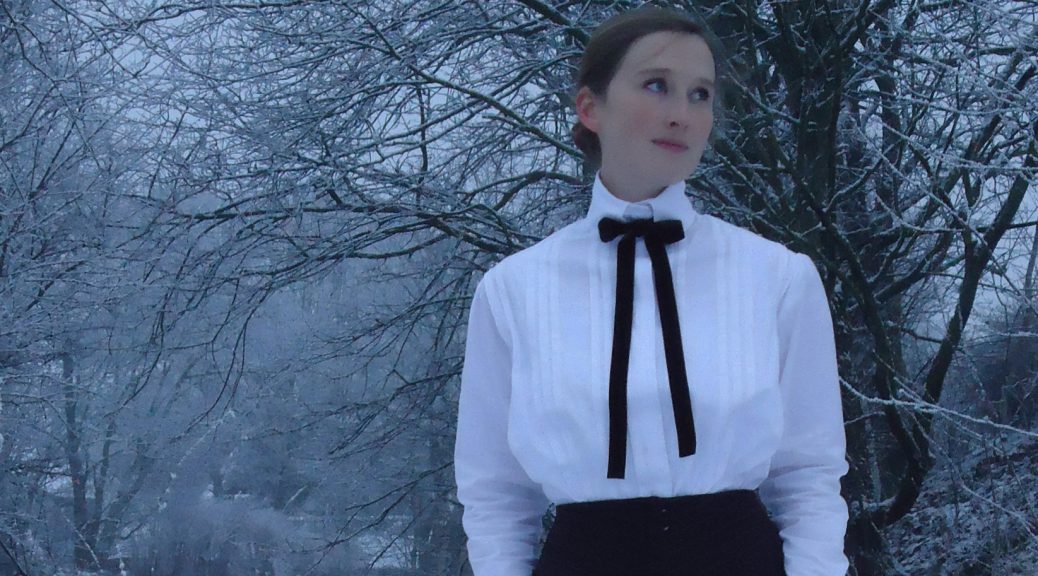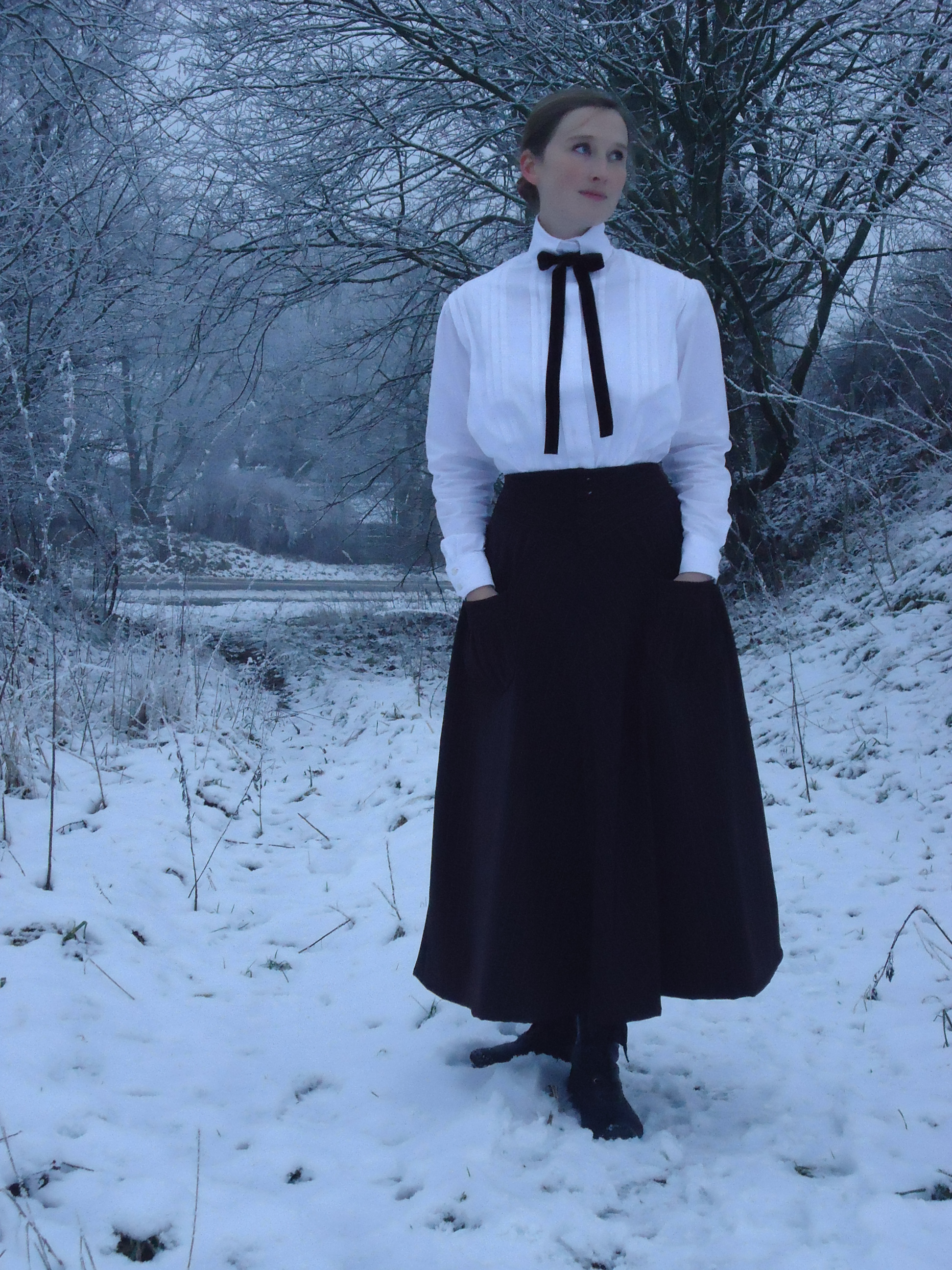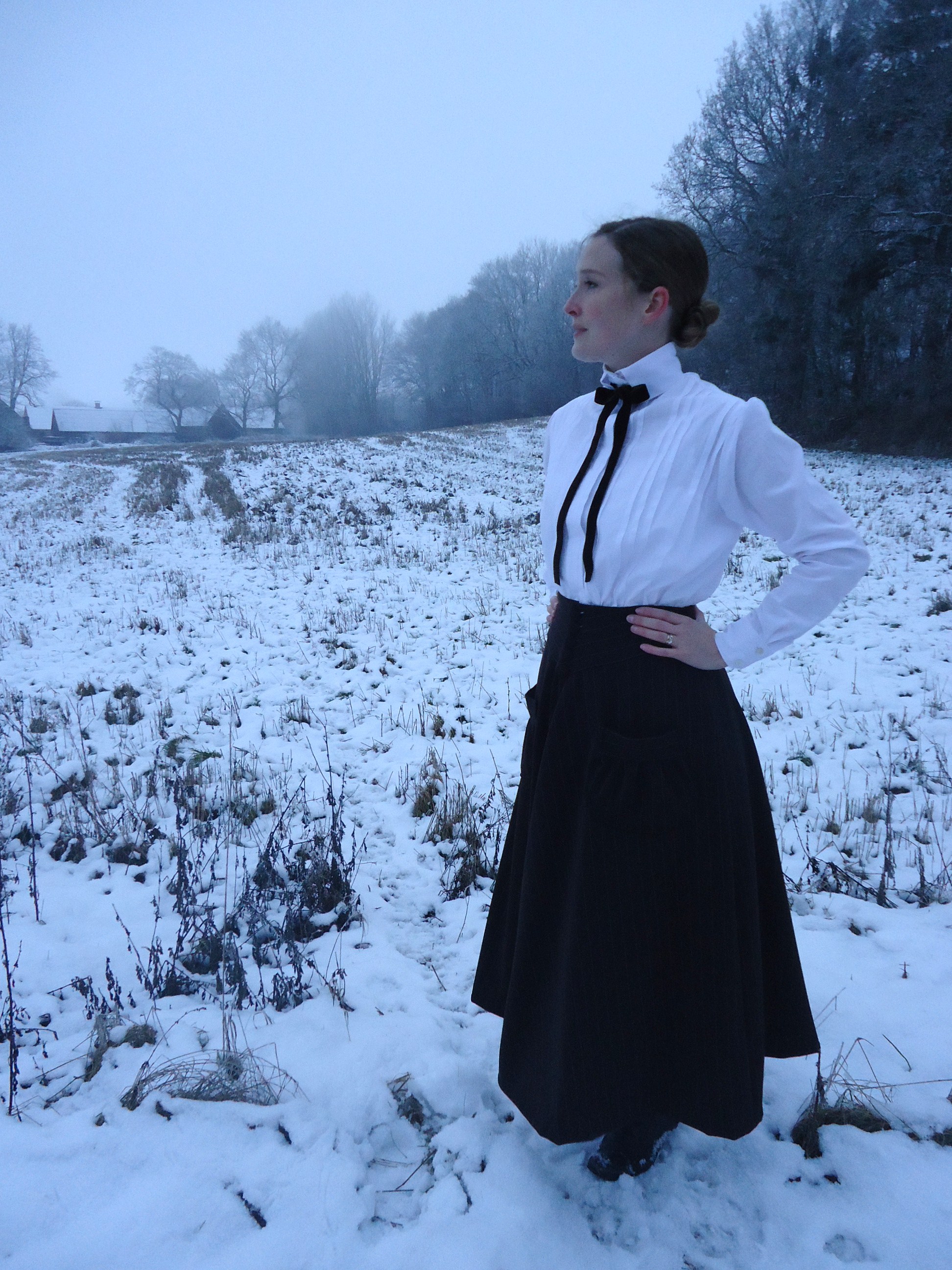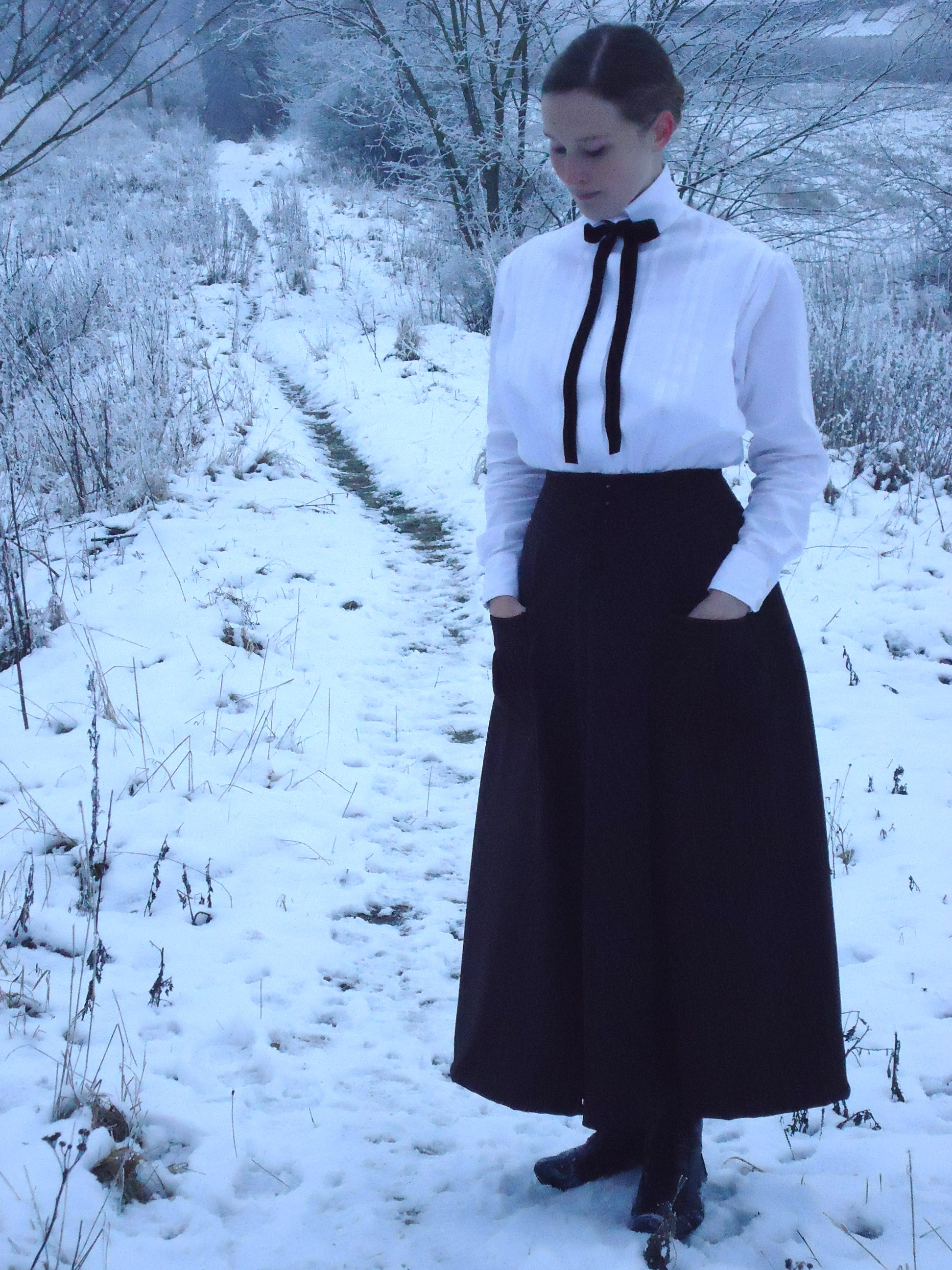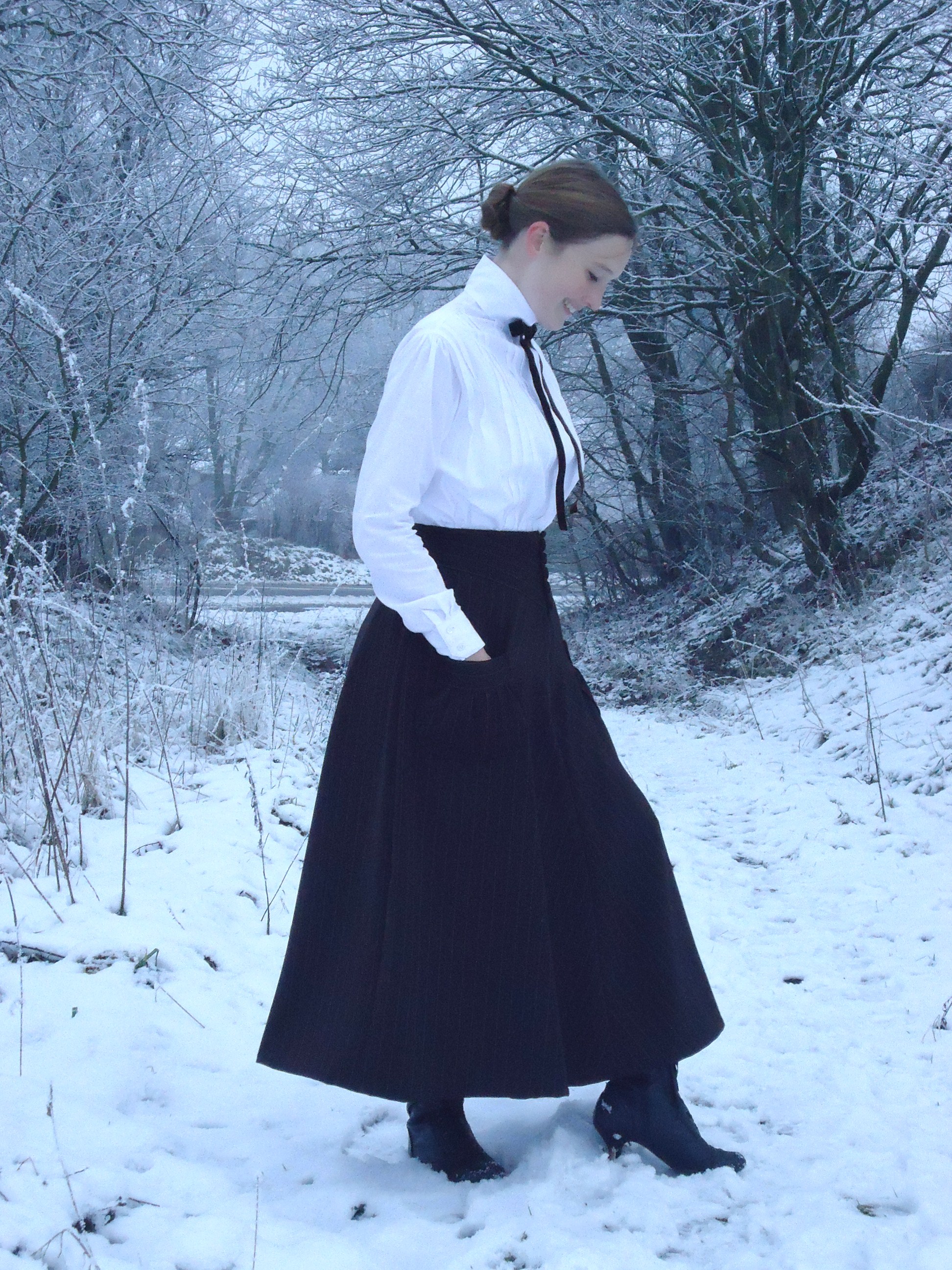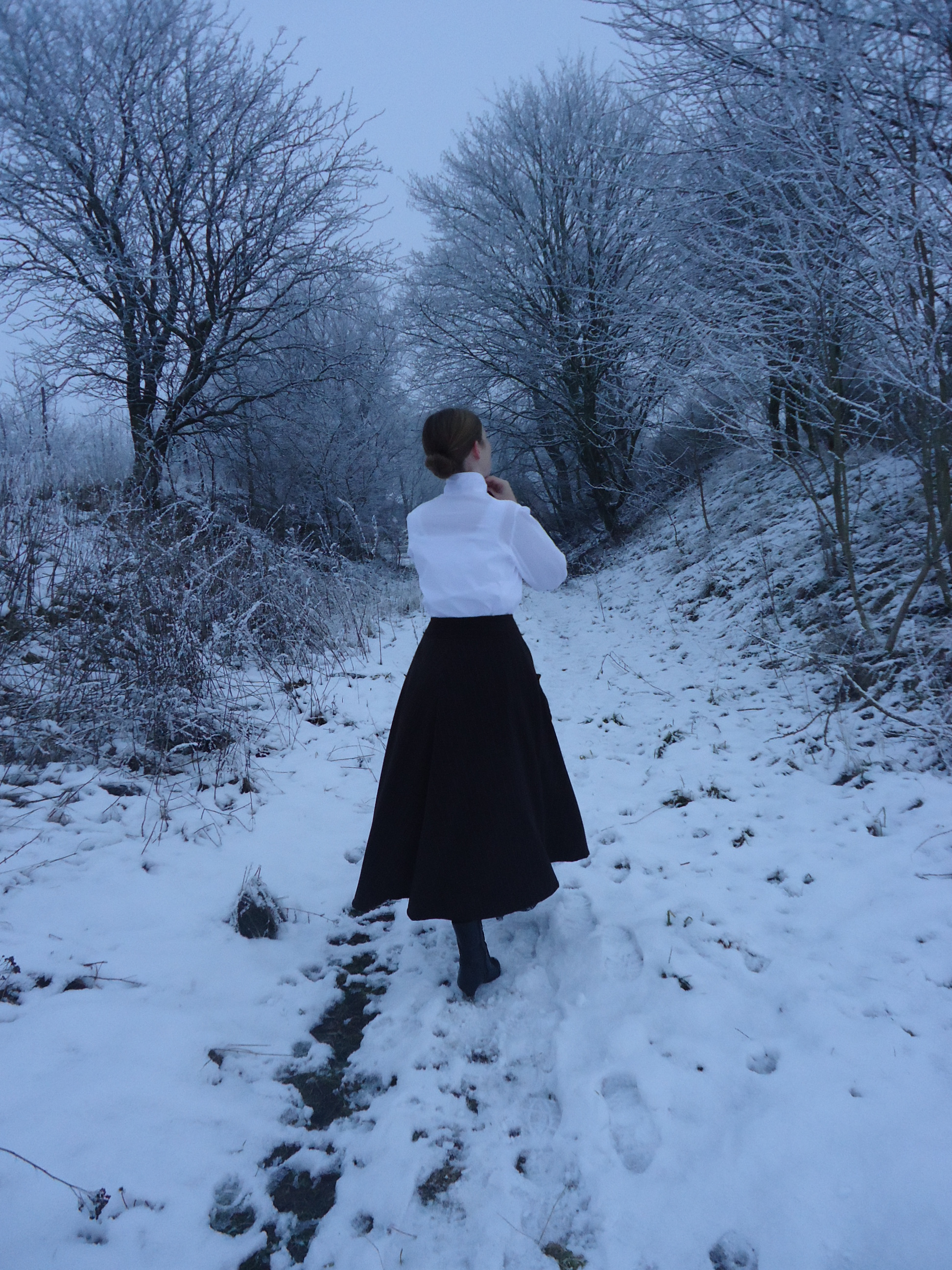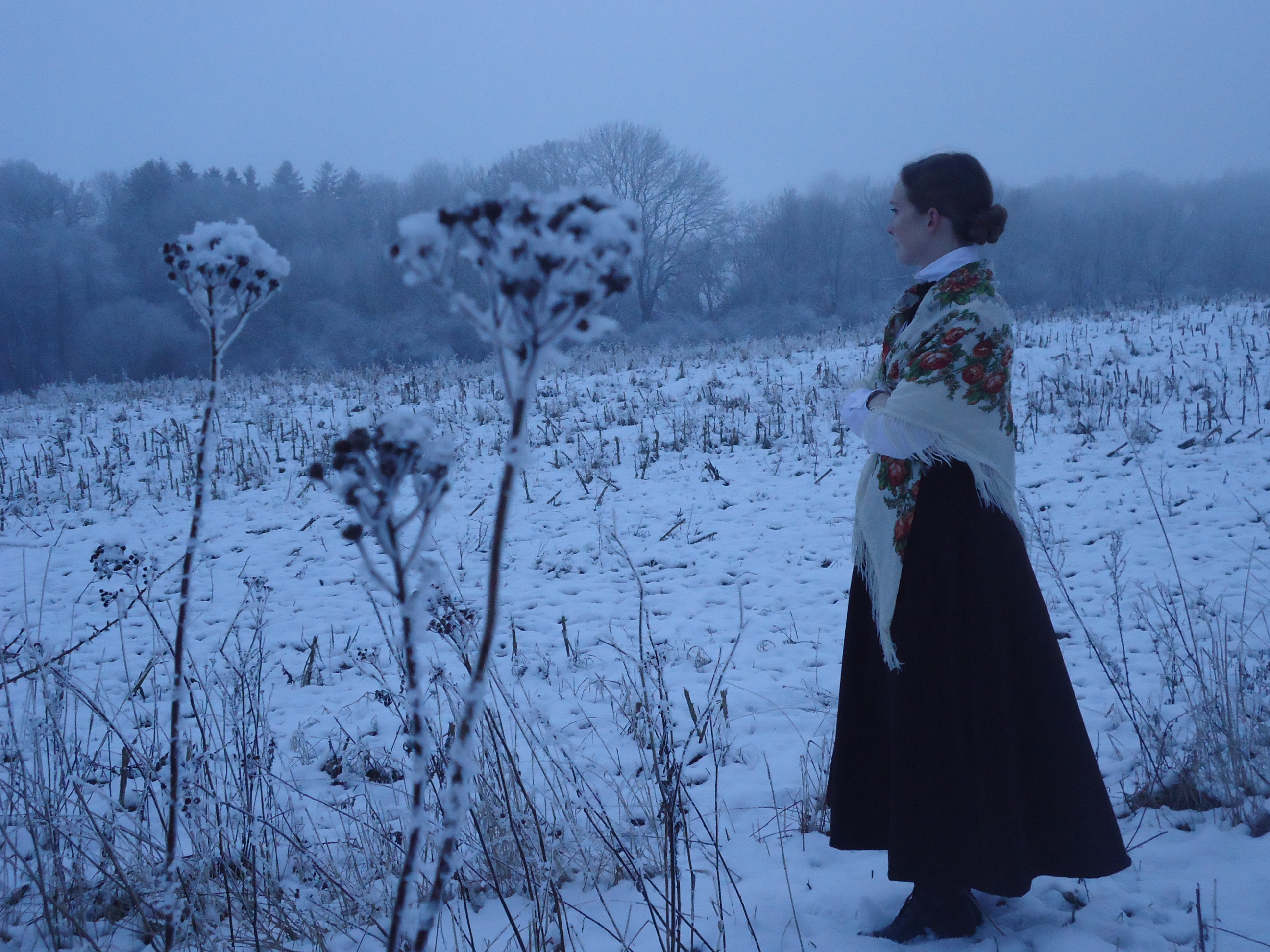Inspiration
 Bilden intill ska föreställa en lärarinna, fotograferad 1914. Detta bekräftade vad jag hade hoppats på, att en proper lärarinna under första världskriget kunde fortsätta ha sina höghalsade blusar från starten av 1910-talet, trots att det verkar ha varit modernt med lägre kragar under 1914-1915.
Bilden intill ska föreställa en lärarinna, fotograferad 1914. Detta bekräftade vad jag hade hoppats på, att en proper lärarinna under första världskriget kunde fortsätta ha sina höghalsade blusar från starten av 1910-talet, trots att det verkar ha varit modernt med lägre kragar under 1914-1915.
The young lady in the picture, from 1914, is a teacher. This proved my thesis, that a decent teacher during the First World War could continue wearing her high necked shirtwaists, even though lower necklines had come into fashion in 1914-1915.
Ytterligare ett exempel, som gav mig vatten på min kvarn, fick jag nu sänt till mig från en annan som är lika tokig i historiska kläder. Fotografiet är från 1916 och lärarinnans dräkt är faktiskt ganska lik den jag har sytt:
Yet another example that kept my hopes of a high necked shirtwaist up, was sent to me by another dear historic fashion nerd. The photo is from 1916 and the teacher actually wears clothes quite similar to those in my sketch.

Som ni förstår, var jag väldigt sugen på att sy just en höghalsad blus, i stil med vad de väna lärarinnorna har i Astrid Lindgren-filmerna. Jag lyckades inte hitta något mönstrat tyg i rätt stil, så jag köpte ett tunt vitt bomullstyg och bestämde mig för att dekorera plagget med stråveck (se skissen i förra inlägget). Jag studerade olika varianter och fann inspiration från följande bilder.
As you are probably well aware, I was very into the idea of making a high necked shirtwaist, in the same style as the lovely teachers in the Astrid Lindgren movies. I wasn’t able to find any cotton with the right type of print, so I ended with buying a white cotton and decided to decorate it with pin tucks (see the sketch in the last blog post). I studied different options and was inspired by the following pictures:
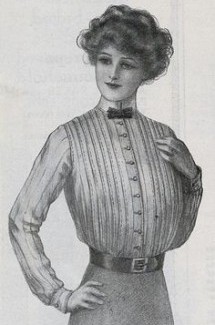
Denna blus (från starten av 1910-talet) vann slutligen mitt hjärta! Jag tycker om hur stråvecken är grupperade och lämnar mer genomskinliga ytor.
This shirtwaist (from the early teens) finally won my heart! I like how the pin tucks are grouped and leave some areas more transparent.
Konstruktionen


Med mycket dåligt samvete, valde jag att inte följa bokens instruktioner för hur man ritar det perfekt anpassade mönstret, med hjälp av måttband, linjal och penna. Istället tog jag den snabba vägen och hängde upp tyget på provdockan och klippte ut rätt form och justerade tills det motsvarade befintliga mönster.
My conscience was very heavy indeed when I chose not to follow the book’s instructions for making the perfectly fitted pattern with the help of measuring tape, ruler and pencil. Instead I took a shortcut, hanging the mockup fabric on the mannequin and cutting the appropriate form and adjusting until it looked like the book’s pattern.
Baktill klippte jag fram passande form på ena halvdelen och kopierade denna till andra halvdelen.
In the back I cut an appropriate form at one side and then copied this to the other side.
Så här såg alla mönsterdelar ut. Den knubbiga rektangeln (manschett) ska klippas ut gånger 2 och den långsmala (krage) gånger 4.
The pattern pieces looked like this. There shall be cut two shubby rectangles (cuff) and four long ones (collar).
Problemen började när jag skulle klippa ut blusens framsida. Först klippte den sömnlösa enligt mönstret, men detta är inte anpassat till stråveckens extra tygåtgång. Sedan räknade jag stråvecken på favoritblusen och kom fram till att det var 9 st på var sida och att de var ungefär 1 cm breda. Därmed la jag till 18 cm över vardera axeln (9*2). Senare insåg jag att inspirationskällans stråveck måste vara smalare, för med 1 cm breda veck fick det inte plats 9 st över mina medelbreda skuldror. Därmed sprättade jag upp dessa yttre veck. Alltså tror jag att man gott kan nöja sig med att lägga till 14-16 cm över skuldrorna. Dessutom skulle jag ha lagt till ytterligare en decimeter mitt fram, på höger framsida, till dekorationen som döljer knäppningen.
The problems came when I started cutting the from of the shirtwaist. First, the sleepless seamstress cut just like the pattern, although this wasn’t adjusted to the extra amount of fabric for the pin tucks. Then I counted the pin tucks on my favourite Pinterest shirtwaist and got nine at each side, about one cm wide. Thus I added 18 cm at the shoulders (9*2). After cutting the fabric, I realised that the pleats of the inspiration source must have been thinner, because the with my one cm wide pleats, the whole width was now too wide for my regular broad shoulders. So I unpicked the peripheral pin tucks. I believe that 14-16 cm extra over the shoulders would suffice. Yet another misstep, was that I should have added one dm at the right part’s front, for the decorative “button hiding place”.
Så här vek jag tyget över knäppningen. Knapphålen sitter i det undre lagret.
This is how I folded the fabric that covers the buttons in the front. The button holes are placed in the lowest layer.
Utecklad, ser viknings-dekorationen, över knäppningen, ut så här. “2 cm-delen” är alltså den del som ligger längst fram. Bredden blir totalt 14 cm från “mitt fram”.
Folded out, the decoration looks like this. The “2 cm part” is the one that is the top layer. The width adds up to 14 cm.
Här syr och stryker jag dekorationen som döljer knäppningen.
Here, I sew and iron the decorative button hiding place.
Här stryker och syr jag stråvecken. Jag tyckte att det var fint att ha 0,5 cm mellanrum mellan de grupperade stråvecken, så avståndet från befintligt veck till nästa vikning är alltså 1,5 cm. Detta stryks och sedan sys med vanlig raksöm 1 cm från den vikta kanten.
Here, I iron and sew the pin tucks. I thought it looked nice with 1/2 cm space between the pleats, so from one pin tuck to the next fold, there is 1,5 cm. This fold is ironed and then stitched with a regular straight seam 1 cm from the fold.

För att blusen inte skulle bli helt oformlig, satte jag in en inpassning, från bysten till botten, ca 2 cm djupt. Till höger ser du vänster framsida innan den sätts ihop med de andra delarna. Vecket längst till höger sprättades upp senare och det överflödiga tyget klipptes bort.
In order to prevent the shirtwaist from becoming totally shapeless, I made a dart from the bust to the bottom, about 2 cm deep. To the right, you see the left front part, before it is put together with the other parts. The pleat at the very right was later unpicked and the superfluous fabric was cut away.
Så här såg det ut när fram- och baksida nålades samman.
This is what it looked like when I had pinned the front panels to the back panel.
Här är ärmar fastnålade och jag experimenterar med kragen, som jag konstaterade faktiskt inte behövde rundas, men kunde vara helt rektangulär, eftersom den skulle sluta tätt runt halsen. Bredden är lika med halsens omkrets plus någon centimeters överlapp, så att man kan knäppa.
Here, the arms are pinned to the bodice and I experiment with the collar – I had expected a need for making the collar rounded, but found out that it actually would fit nicely round the neck when just left rectangular. The collar width is the same as the neck width plus some cm overlap for buttoning.
Jag sydde först längs kanterna på den nerfällda delen av kragen, vrängde, strök och la in mellan de båda styckena närmast halsen. Sedan sydde jag längs vikningskanten. Därefter strök jag igen och sedan kunde jag fästa kragen på blusen.
First I sewed along the borders of the collar on the wrong side, then turned the right side ought, ironed it and put the collar in between the standing part of the collar, closest to the neck. Then I stitched these parts together. I ironed again and then I attached the collar to the shirtwaist.
Jag märkte ut knapphålens placering med 4,5 cm avstånd, från kragens topp ned till botten.
I marked the placement of the button holes, 4,5 cm apart, from the top of the collar to the hemline.
Sedan sydde jag knapphålen på maskin och fäste gamla ärvda plastknappar med motsvarande placering.
Then I sewed the button holes on machine and fastened some inherited plastic buttons accordingly.
Sist av allt fållade jag nederkanten och fäste manschetterna. Jag använde ärvda knappar även till dessa, men här är de av pärlemor.
Last of all, I hemmed the bottom of the bodice and attached the cuffs. I used inherited buttons here too, but these were mother of pearl.
Dräkten

